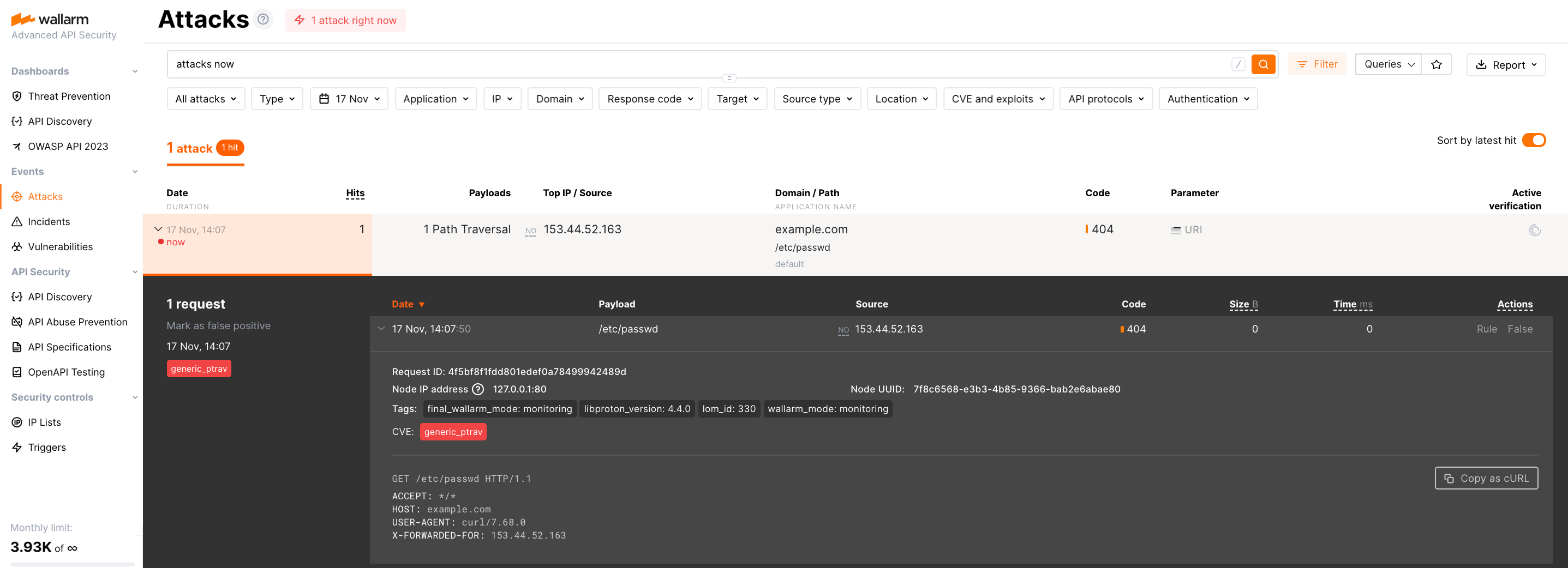Azion Edge Firewall with Wallarm Functions¶
Azion Edge Functions enable the execution of custom code at the network edge, allowing for the implementation of customer rules to handle requests. By incorporating Wallarm custom code, incoming traffic can be proxied to the Wallarm node for analysis and filtering. This setup enhances the security measures already provided by Azion Edge Firewall. This guide provides instructions on how to integrate the Wallarm node with Azion Edge to protect services running on Azion Edge.
The solution involves deploying the Wallarm node externally and injecting custom code or policies into the specific platform. This enables traffic to be directed to the external Wallarm node for analysis and protection against potential threats. Referred to as Wallarm's connectors, they serve as the essential link between platforms like Azion Edge, Akamai Edge, MuleSoft, Apigee, and AWS Lambda, and the external Wallarm node. This approach ensures seamless integration, secure traffic analysis, risk mitigation, and overall platform security.
Use cases¶
Among all supported Wallarm deployment options, this solution is the recommended one for the following use cases:
-
Securing APIs or traffic running on Azion Edge.
-
Requiring a security solution that offers comprehensive attack observation, reporting, and instant blocking of malicious requests.
Limitations¶
The solution has certain limitations as it only works with incoming requests:
-
Vulnerability discovery using the passive detection method does not function properly. The solution determines if an API is vulnerable or not based on server responses to malicious requests that are typical for the vulnerabilities it tests.
-
The Wallarm API Discovery cannot explore API inventory based on your traffic, as the solution relies on response analysis.
-
The protection against forced browsing is not available since it requires response code analysis.
Requirements¶
To proceed with the deployment, ensure that you meet the following requirements:
-
Understanding of Azion Edge technologies
-
APIs or traffic running on Azion Edge.
Deployment¶
To secure APIs on Azion Edge with Wallarm, follow these steps:
-
Deploy a Wallarm node using one of the available deployment options.
-
Obtain the Wallarm code for Edge Functions and run it on Azion.
1. Deploy a Wallarm node¶
When utilizing Wallarm on Azion Edge, the traffic flow is in-line.
-
Choose one of the supported Wallarm node deployment solutions or artifacts for in-line deployment and follow the provided deployment instructions.
-
Configure the deployed node using the following template:
server { listen 80; server_name _; access_log off; wallarm_mode off; location / { proxy_set_header Host $http_x_forwarded_host; proxy_pass http://unix:/tmp/wallarm-nginx.sock; } } server { listen 443 ssl; server_name yourdomain-for-wallarm-node.tld; ### SSL configuration here access_log off; wallarm_mode off; location / { proxy_set_header Host $http_x_forwarded_host; proxy_pass http://unix:/tmp/wallarm-nginx.sock; } } server { listen unix:/tmp/wallarm-nginx.sock; server_name _; wallarm_mode monitoring; #wallarm_mode block; real_ip_header X-EDGEWRK-REAL-IP; set_real_ip_from unix:; location / { echo_read_request_body; } }Please ensure to pay attention to the following configurations:
- TLS/SSL certificates for HTTPS traffic: To enable the Wallarm node to handle secure HTTPS traffic, configure the TLS/SSL certificates accordingly. The specific configuration will depend on the chosen deployment method. For example, if you are using NGINX, you can refer to its article for guidance.
- Wallarm operation mode configuration.
-
Once the deployment is complete, make a note of the node instance IP as you will need it later to set the address for incoming request forwarding.
2. Obtain the Wallarm code for Edge Functions and run it on Azion¶
To acquire and run the Wallarm code for Azion Edge Functions, follow these steps:
-
Contact support@wallarm.com to obtain the Wallarm code.
-
On Azion Edge, go to Billing & Subscriptions and activate subscription on Application Acceleration and Edge Functions.
-
Create a new Edge Application and save it.
-
Open the created application → Main Settings and enable Application Acceleration and Edge Functions.
-
Navigate to Domains and click Add Domain.
-
Navigate to Edge Functions, click Add Function and choose the
Edge Firewalltype. -
Paste the Wallarm source code replacing
wallarm.node.tldwith the address of previously deployed Wallarm node. -
Go to Edge Firewall → Add Rule Set → type Name → select Domains and turn on Edge Functions.
-
Switch to the Functions tab, click Add Function and select the previously created function.
-
Switch to the Rules Engine tab → New Rule and set the criteria for traffic to be filtered by Wallarm:
- To analyze and filter all request, select
If Request URI starts with /. - In Behaviors, choose
Then Run Functionand select the previously created function.
- To analyze and filter all request, select
Testing¶
To test the functionality of the deployed policy, follow these steps:
-
Send the request with the test Path Traversal attack to your API:
-
Open Wallarm Console → Attacks section in the US Cloud or EU Cloud and make sure the attack is displayed in the list.
If the Wallarm node mode is set to blocking, the request will also be blocked.
Need assistance?¶
If you encounter any issues or require assistance with the described deployment of Wallarm in conjunction with Azion Edge, you can reach out to the Wallarm support team. They are available to provide guidance and help resolve any problems you may face during the implementation process.
